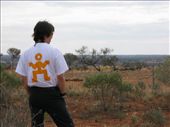 When people told us about the colours of the outback – the stark contrast between the red of the dirt with the blue of the sky, and the silvery green of the eucalypt trees that dot the landscape – we were somewhat blasé about it. We knew it would be beautiful, but really.
When people told us about the colours of the outback – the stark contrast between the red of the dirt with the blue of the sky, and the silvery green of the eucalypt trees that dot the landscape – we were somewhat blasé about it. We knew it would be beautiful, but really.
And when people told us of the vast nothingness that we’d encounter – some people speaking of 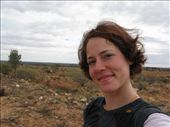 the isolation with fondness, and others with uncomfortable dislike – we also were a little blasé about it. We knew it would be isolated, but really.
the isolation with fondness, and others with uncomfortable dislike – we also were a little blasé about it. We knew it would be isolated, but really.
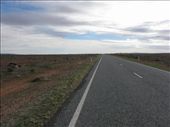 Being from Canada, everywhere we turn, we se many similarities between Australia and our home country. From both being Commonwealth countries, to vast amounts of land and small populations, to large chunks of essentially uninhabitable land, to politics, to aboriginal issues – you name it. There are many similarities, which is why we are generally so comfortable and happy here in Oz. It feels like home.
Being from Canada, everywhere we turn, we se many similarities between Australia and our home country. From both being Commonwealth countries, to vast amounts of land and small populations, to large chunks of essentially uninhabitable land, to politics, to aboriginal issues – you name it. There are many similarities, which is why we are generally so comfortable and happy here in Oz. It feels like home.
And even venturing into the Outback, we knew we’d feel a sense of home – large flat chunks of 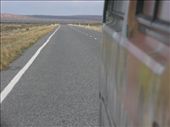 land that go on forever. It screams of Canada’s prairies to us, except we trade unending fields of wheat for unending pastures of scrubby brush dotted with the odd goat or sheep.
land that go on forever. It screams of Canada’s prairies to us, except we trade unending fields of wheat for unending pastures of scrubby brush dotted with the odd goat or sheep.
But to really see it, to see the dirt go from white to yellow to brown to rust, and eventually to deep burnt sienna red, is quite incredible.
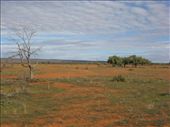 To see the landscape change from hilly and full of trees, to so flat that you can see the trunks of trees miles off on the shining horizon. To eventually almost no trees, save for the odd river gum or eucalypt, and a loose dusting of scrubby brush. Wow.
To see the landscape change from hilly and full of trees, to so flat that you can see the trunks of trees miles off on the shining horizon. To eventually almost no trees, save for the odd river gum or eucalypt, and a loose dusting of scrubby brush. Wow.
No wonder so many world-renowned artists derive their inspiration from and continue to live in 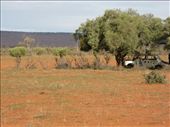 the Australian Outback.
the Australian Outback.
Interestingly, some people we talked to really dislike the Outback. They wondered why we would want to drive all the way out to Broken Hill, when we could enjoy the east coast and its action all the way from Brisbane to Melbourne. Yet other people emphatically told us to give the east coast a miss for the Outback. And from both those who love and those who don’t love it, we received words of caution, and were asked if we had ever traveled remotely and knew how to prepare for it.
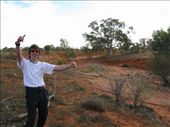 Admittedly, it is a little unnerving when petrol stations are hundreds of kilometers apart, and nothing – not a drop of water, not a store, nothing – is the void that separates the tiny towns or service areas. But was it scary? No. We found it liberating more than scary.
Admittedly, it is a little unnerving when petrol stations are hundreds of kilometers apart, and nothing – not a drop of water, not a store, nothing – is the void that separates the tiny towns or service areas. But was it scary? No. We found it liberating more than scary.
But to say that the Outback is a whole lot of nothing is a fallacy. As we were driving through these remote areas, I was looking for the “vast nothingness” that I was promised. But I never found it.
Instead, I found the odd windmill. Or radio tower. Or flock of sheep, or even a small herd of 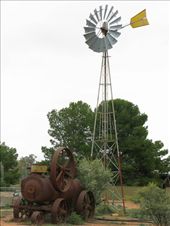 cows. Which told me that this chunk of land, however big it was, was a home to somebody. The occasional gate with a small dirt drive winding away into the horizon was proof of life out here in the vast Outback.
cows. Which told me that this chunk of land, however big it was, was a home to somebody. The occasional gate with a small dirt drive winding away into the horizon was proof of life out here in the vast Outback.
No matter how big and remote and vast this country is, it is still accessible and home to somebody.
We later learned that the largest piece of land owned (or rather leased from the Crown) by anybody is a cattle station that is 330,000 square kilometers. This is an amount of space I can’t even begin to conceive. How the heck do you round up cattle scattered over 330,000 square kilometers?!?!
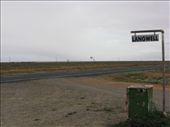 And of course, this isn’t the only chunk of vast “nothingness” that is a living and home to somebody. In fact, learning of these huge chunks of outback, and seeing by the map that we are only skirting the edge of it by going to Broken Hill (known as the “easily accessible Outback”), makes me want to go even further into the Outback! I want to see more of the remote beauty of Australia that gives it character and colour.
And of course, this isn’t the only chunk of vast “nothingness” that is a living and home to somebody. In fact, learning of these huge chunks of outback, and seeing by the map that we are only skirting the edge of it by going to Broken Hill (known as the “easily accessible Outback”), makes me want to go even further into the Outback! I want to see more of the remote beauty of Australia that gives it character and colour.
But alas, both time and the lack of a four-wheel drive brigade (and money for petrol, which is 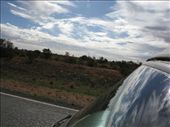 over $1.70/liter in some places!) has limited our Outback adventure to a mere brush with this beauty.
over $1.70/liter in some places!) has limited our Outback adventure to a mere brush with this beauty.
To us, the Outback is captivating, alluring, a little foreboding, and truly mesmerizing. It is yet another aspect of this vast and gorgeous country with its diversity. We can’t wait to see what’s around the next corner.
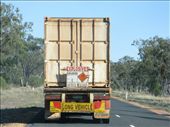
Yup, Mum: We drove behind (and pas sed) a road train full of explosives. Not a truck - a ROAD TRAIN. These vehicles dwarf the transport trucks of North America, and can be up to 50 meters long! But don't worry: we lived to tell the tale!
sed) a road train full of explosives. Not a truck - a ROAD TRAIN. These vehicles dwarf the transport trucks of North America, and can be up to 50 meters long! But don't worry: we lived to tell the tale!